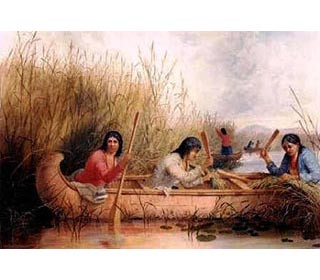- Name of Group: Great Basin Indians - the Desert culture, the seed gatherers
- Languages: Shoshonean and Uto-Aztecan (Numic)
- Geography of the State of Great Basin Indians: Deserts, salt flats and brackish lakes
- Animals: Sheep, squirrels, rabbits, deer, antelope, bison (buffalo)
- Natural Resources: Sagebrush, grasslands, seeds, roots, wild rice
- Culture and Lifestyle adopted: Nomadic Hunter gatherers
- Art: Basket making
- Types of housing, homes or shelters: Grass Houses
- Famous Tribes of Great Basin Indians: Shoshone, Bannock, Paiute and Ute
- The Native Indians who lived on the borders of lands often reflected two different types of lifestyles.
Great Basin Indians - Lifestyle (Way of Living)
The climate, land and natural resources that were available to the Indian tribes resulted in the adoption of the Great Basin Indians culture. The basic Great Basin social and cultural patterns were those of the non-horse bands often referred to as the Desert Culture. The desert climate of the region and apparent lack of economic and subsistence resources led to the migration of many of the people. The Comanche and Eastern Shoshone were early Great Basin tribes who moved to the north and east, where they developed the horse-riding bison-hunting culture of the Great Plains Indians. Great Basin Indians - Religion, Ceremonies and Beliefs
The Religion, Ceremonies and Beliefs were based on Animism. Animism was a commonly shared doctrine, or belief, of the indigenous people of North America and Canada including the Great Basin Indian tribes. Animism is based on the spiritual or religious idea that the universe and all natural objects have souls or spirits. In this religion it is believed that souls or spirits exist not only in humans but also in animals, plants, trees, rocks etc. This belief is also extended to natural phenomena such as thunder storms and rain and geographic features such as mountains, caves or rivers also possess souls or spirits. Tricksters feature in the legends and mythology of the Great Basin peoples as do heroic figures or "transformers" who transform, or change, the world into its present state. Great Basin Indians - The Shaman
The Religion, Ceremonies and Beliefs of the Great Basin Indians were also dominated by Shamanism in which a religious leader, called a Shaman, acted as a medium between the visible and spirit worlds. The majority of Great Basin shamans were males but female shamans were not uncommon. Great Basin Indians - Ceremonies
The Ute Bear Dance and the Sun Dance first emerged in the Great Basin as did the Ghost Dance. Two Paiute prophets named Wodziwob and Wovoka, introduced the Ghost Dance in a mystical ceremony designed to re-establish the native culture and restore the environment to pre-European levels. Other ceremonies included the Round Dance which was associated with the pinyon harvest and aimed at increasing the food supply and bringing rain. Great Basin Indians - Languages
The languages of the Great Basin Indians included Shoshonean and Uto-Aztecan (Numic). Great Basin Indians - Physical Characteristics
The physical characteristics of Great Basin Indians are dark brown eyes, prominent cheek bones, straight black hair, and scantiness of beard. The skin color of Native Indians varies from very light in some tribes such as the Cheyenne, to almost black in others, such as the Caddo and a yellowish color in such as the Flatheads.
Great Basin Indians - Geography and Environment
The Geography and Environment can be generally described as dry, desert areas with very low levels of rainfall. There are high mountains and arid plains and deserts, deep canyons and occasional lakes. Very hot summers and cold winters. The Basin Indians acquired horses from the Europeans in the 1700's and many migrated to the Great Plains to hunt buffalo.
Great Basin Indians - Animals
The animals available to the Great Basin Indians included deer, sheep, antelope, rabbits, hares, reptiles, snakes, insects and fish. Great Basin Indians - Natural Resources
The sparse natural resources included seeds, berries, nuts, roots, leaves, stalks and bulbs. The principal resource were pinyon nuts (pine nuts). Seed bearing grass species, such as Indian rice grass were common in the high desert areas and important to the food supply of many of the peoples. Great Basin Indians - Houses, Shelters and Homes
The different types of Houses, Shelters and Homes depended on the materials available and whether the home was permanent or temporary. The homes of the Great Basin Indians included Hogans. |
